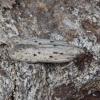35.085 Athrips mouffetella (Linnaeus, 1758)
Status and Distribution
Locally common over much of England and Wales becoming local or very local in south-western and northern England, west Wales and Ireland. There is a single 19th Century record from southern Scotland (Berwickshire); the moth is apparently absent from Northern Ireland and the Channel Islands.

Provisional map
Foodplant and Larval Feeding Signs
Lonicera periclymenum (honeysuckle), see plant distribution map, Lonicera xylosteum (fly honeysuckle) and Symphoricarpos rivularis (snowberry).
In Europe also found on Lonicera caprifolium (perfoliate honeysuckle) and possibly Berberis, although the latter is doubtful and requires verification.
Feeds from a dense white silken spinning amongst shoots.
Habitat
Woodlands, hedgerows and gardens.
Finding the Moth
Larva: in a dense white silken retreat amongst several terminal leaves of a shoot. The larva of Ypsolopha dentella and Y. nemorella feed in a similar way but can be separated on the larval colour. A. mouffetella larva have a black head and prothoracic plate and are purplish black or dark grey with some white spotting and streaking (see photos); Y. dentella is green with a reddish brown dorsal stripe; Y. nemorella is pale reddish brown without any prominent striping. Ditula angustiorana has also been reared from a similar terminal spinning on honeysuckle, but the larva of this species is pale yellowish or greyish white.
Adult: generally retiring but has been found resting on a fence close to its foodplant and comes readily to light. Two are reported being attracted to a Grapholita funebrana pheromone lure in Kent in 2012.
Similar Species
The combination of grey forewing and distinctive layout of the black spots are only found in this species. Other moths of this size with grey wings and a different layout of black spots are Ethmia dodecea, where the black spots are more extensive and larger, and grey Yponomeuta species where the spots are much more extensive.
Single brooded from mid-June to late August.
Earliest: 11th May 2008 (VC11) which is exceptionally early for this moth; next earliest 27th May 2006 (VC37)
Latest: 5th September 2009 (VC1)








